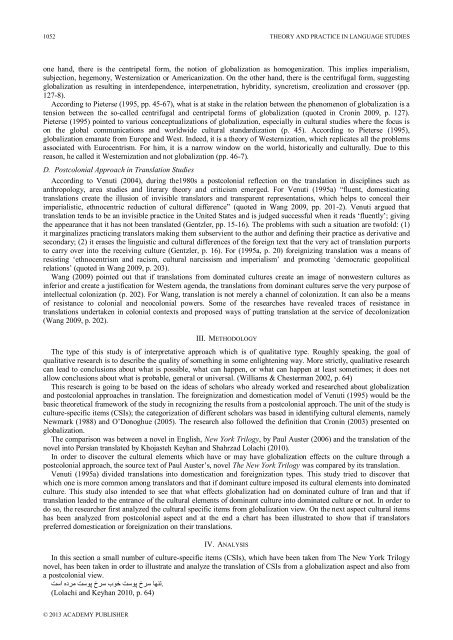Theory and Practice in Language Studies Contents - Academy ...
Theory and Practice in Language Studies Contents - Academy ...
Theory and Practice in Language Studies Contents - Academy ...
Create successful ePaper yourself
Turn your PDF publications into a flip-book with our unique Google optimized e-Paper software.
1052 THEORY AND PRACTICE IN LANGUAGE STUDIESone h<strong>and</strong>, there is the centripetal form, the notion of globalization as homogenization. This implies imperialism,subjection, hegemony, Westernization or Americanization. On the other h<strong>and</strong>, there is the centrifugal form, suggest<strong>in</strong>gglobalization as result<strong>in</strong>g <strong>in</strong> <strong>in</strong>terdependence, <strong>in</strong>terpenetration, hybridity, syncretism, creolization <strong>and</strong> crossover (pp.127-8).Accord<strong>in</strong>g to Pieterse (1995, pp. 45-67), what is at stake <strong>in</strong> the relation between the phenomenon of globalization is atension between the so-called centrifugal <strong>and</strong> centripetal forms of globalization (quoted <strong>in</strong> Cron<strong>in</strong> 2009, p. 127).Pieterse (1995) po<strong>in</strong>ted to various conceptualizations of globalization, especially <strong>in</strong> cultural studies where the focus ison the global communications <strong>and</strong> worldwide cultural st<strong>and</strong>ardization (p. 45). Accord<strong>in</strong>g to Pieterse (1995),globalization emanate from Europe <strong>and</strong> West. Indeed, it is a theory of Westernization, which replicates all the problemsassociated with Eurocentrism. For him, it is a narrow w<strong>in</strong>dow on the world, historically <strong>and</strong> culturally. Due to thisreason, he called it Westernization <strong>and</strong> not globalization (pp. 46-7).D. Postcolonial Approach <strong>in</strong> Translation <strong>Studies</strong>Accord<strong>in</strong>g to Venuti (2004), dur<strong>in</strong>g the1980s a postcolonial reflection on the translation <strong>in</strong> discipl<strong>in</strong>es such asanthropology, area studies <strong>and</strong> literary theory <strong>and</strong> criticism emerged. For Venuti (1995a) “fluent, domesticat<strong>in</strong>gtranslations create the illusion of <strong>in</strong>visible translators <strong>and</strong> transparent representations, which helps to conceal theirimperialistic, ethnocentric reduction of cultural difference” (quoted <strong>in</strong> Wang 2009, pp. 201-2). Venuti argued thattranslation tends to be an <strong>in</strong>visible practice <strong>in</strong> the United States <strong>and</strong> is judged successful when it reads „fluently‟; giv<strong>in</strong>gthe appearance that it has not been translated (Gentzler, pp. 15-16). The problems with such a situation are twofold: (1)it marg<strong>in</strong>alizes practic<strong>in</strong>g translators mak<strong>in</strong>g them subservient to the author <strong>and</strong> def<strong>in</strong><strong>in</strong>g their practice as derivative <strong>and</strong>secondary; (2) it erases the l<strong>in</strong>guistic <strong>and</strong> cultural differences of the foreign text that the very act of translation purportsto carry over <strong>in</strong>to the receiv<strong>in</strong>g culture (Gentzler, p. 16). For (1995a, p. 20) foreigniz<strong>in</strong>g translation was a means ofresist<strong>in</strong>g „ethnocentrism <strong>and</strong> racism, cultural narcissism <strong>and</strong> imperialism‟ <strong>and</strong> promot<strong>in</strong>g „democratic geopoliticalrelations‟ (quoted <strong>in</strong> Wang 2009, p. 203).Wang (2009) po<strong>in</strong>ted out that if translations from dom<strong>in</strong>ated cultures create an image of nonwestern cultures as<strong>in</strong>ferior <strong>and</strong> create a justification for Western agenda, the translations from dom<strong>in</strong>ant cultures serve the very purpose of<strong>in</strong>tellectual colonization (p. 202). For Wang, translation is not merely a channel of colonization. It can also be a meansof resistance to colonial <strong>and</strong> neocolonial powers. Some of the researches have revealed traces of resistance <strong>in</strong>translations undertaken <strong>in</strong> colonial contexts <strong>and</strong> proposed ways of putt<strong>in</strong>g translation at the service of decolonization(Wang 2009, p. 202).III. METHODOLOGYThe type of this study is of <strong>in</strong>terpretative approach which is of qualitative type. Roughly speak<strong>in</strong>g, the goal ofqualitative research is to describe the quality of someth<strong>in</strong>g <strong>in</strong> some enlighten<strong>in</strong>g way. More strictly, qualitative researchcan lead to conclusions about what is possible, what can happen, or what can happen at least sometimes; it does notallow conclusions about what is probable, general or universal. (Williams & Chesterman 2002, p. 64)This research is go<strong>in</strong>g to be based on the ideas of scholars who already worked <strong>and</strong> researched about globalization<strong>and</strong> postcolonial approaches <strong>in</strong> translation. The foreignization <strong>and</strong> domestication model of Venuti (1995) would be thebasic theoretical framework of the study <strong>in</strong> recogniz<strong>in</strong>g the results from a postcolonial approach. The unit of the study isculture-specific items (CSIs); the categorization of different scholars was based <strong>in</strong> identify<strong>in</strong>g cultural elements, namelyNewmark (1988) <strong>and</strong> O‟Donoghue (2005). The research also followed the def<strong>in</strong>ition that Cron<strong>in</strong> (2003) presented onglobalization.The comparison was between a novel <strong>in</strong> English, New York Trilogy, by Paul Auster (2006) <strong>and</strong> the translation of thenovel <strong>in</strong>to Persian translated by Khojasteh Keyhan <strong>and</strong> Shahrzad Lolachi (2010).In order to discover the cultural elements which have or may have globalization effects on the culture through apostcolonial approach, the source text of Paul Auster‟s, novel The New York Trilogy was compared by its translation.Venuti (1995a) divided translations <strong>in</strong>to domestication <strong>and</strong> foreignization types. This study tried to discover thatwhich one is more common among translators <strong>and</strong> that if dom<strong>in</strong>ant culture imposed its cultural elements <strong>in</strong>to dom<strong>in</strong>atedculture. This study also <strong>in</strong>tended to see that what effects globalization had on dom<strong>in</strong>ated culture of Iran <strong>and</strong> that iftranslation leaded to the entrance of the cultural elements of dom<strong>in</strong>ant culture <strong>in</strong>to dom<strong>in</strong>ated culture or not. In order todo so, the researcher first analyzed the cultural specific items from globalization view. On the next aspect cultural itemshas been analyzed from postcolonial aspect <strong>and</strong> at the end a chart has been illustrated to show that if translatorspreferred domestication or foreignization on their translations.IV. ANALYSISIn this section a small number of culture-specific items (CSIs), which have been taken from The New York Trilogynovel, has been taken <strong>in</strong> order to illustrate <strong>and</strong> analyze the translation of CSIs from a globalization aspect <strong>and</strong> also froma postcolonial view..تىٍا سزخ پُست خُب سزخ پُست مزدي است(Lolachi <strong>and</strong> Keyhan 2010, p. 64)© 2013 ACADEMY PUBLISHER
















